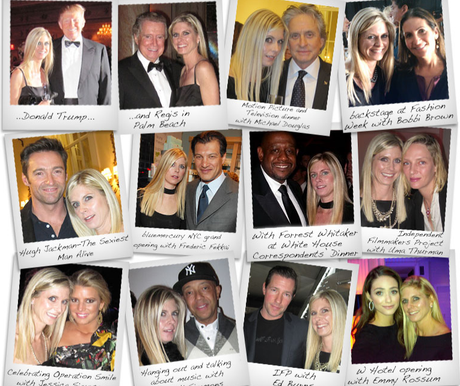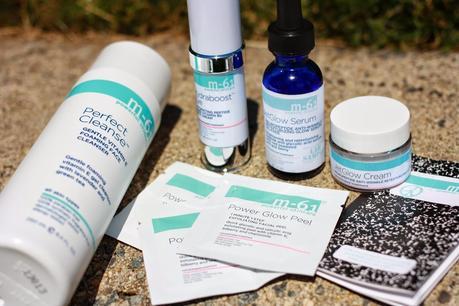 Beck and the Beautiful People
Beck and the Beautiful PeopleImage c/o Bluemercury
Interview by Renata Certo-Ware
It's not hard to believe that Marla Beck, a sunny, towheaded Jennifer Aniston look-alike, is in the beauty biz. With a bevy of degrees under her belt (including two - count 'em, two! - Master's Degrees from Harvard University), Bluemercury's co-founder and CEO delivers a refreshing and inspiring Brains-and-Beauty one-two punch.
A decade and a half ago, she, along with husband Barry Beck, built a company on principals she learned at Harvard, a bit of instinct, and her love of the perfect shade of lipstick, which before Bluemercury, she had to make hour-long pilgrimages to find.
Now, when talking about the company the Becks built, she makes numerous parallels between the twin industries of fashion and beauty, referencing certain products as the "fast-fashion" of beauty, and instructing that every product from M61, her two year old line of in-house products, was "made to wardrobe."
Already beloved for its old-school apothecary experience - by design, not coincidence - the beauty product purveyor's next move is a strengthened effort to incorporate technology into the business to get to know customers even better.
We stopped by Bluemercury's Chestnut Hill, MA location - their 50th store! - to chat about the evolution of the company, her new line, and just how many products she uses each day.

One of the pivotal scenes in the PBS series Mr. Selfridge - a scene that really introduced and defined the titular character - showed how he was the first to bring toiletries out from the dark recesses of the top floor lingerie section and out onto the first floor, right by the entrances for all to see, where they still remain to this day - a move that at the time scandalized some of London's more traditional souls. Your first objective when you started Bluemercury was to take makeup and beauty products one step further, bringing them out into the open where customers are encouraged to look, touch, and test-drive them. How has that business model evolved and what do you see as the next step in that evolution?
When I really think about the next wave, it's about becoming truly omni-channel: How can we link technology to the retail experience? That's the next wave. I really want a client to walk into the store, and on my iPhone, your picture comes up and I can see what you bought last time so I can check in with you and say "How did you like that cream?", or "Is that scrub working for you?" or "Do you need help re-learning how to apply that eyeliner?". It's about making it a very personal in-store experience, really knowing your customer without having the same conversation over and over again. I also think about the customization we're going to be able to do; We're working on a mobile app, so as we launch new products, we're going to be able to push them to your iPhone based on your past purchases.
The other thing we need to figure out is: If you talk to people, the most confusing thing for a lot of them is "What order do I use this stuff?" We do prescription pads, but if I had all the products I bought here, could I quickly take a picture with my iPhone and immediately get directions sent to me? It's about how you use technology to get a better experience with the product. We're currently working on some of this with a Boston firm - but I won't tell you which one! We're trying to think about what we can do now to prepare ourselves for the future. Oh, and there's that new technology where you'll be able to print products at home...
That was created by a Harvard alumna as well!
I think that's pretty amazing! You can imagine having customized skincare that you can print at home.
How would Blue Mercury be involved in that?
We have our own line, M61, so imagine a cleanser - maybe you buy a base formula and there are a couple adjustments based on your skin type, with a little bit more glycolic acid, a little bit less, or with more of a soother for irritated skin. It's just like cooking - you have a base recipe, and you're adding more to it. So rather than having ten different products, you end up with thousands of opportunities in one product. I believe that's still a ways away from happening, but maybe I'm wrong.
It's a very interesting combination of past and future business models! You speak about adding an element of technology to propel your business into the future, but you also really indentify with the neighborhood apothecary philosophy, an idea that predates department stores. What does neighborhood mean to you?
It's very hard to define and quantify a concept like customer service - how do you know you're doing a good job with it? So if a client is smiling when they are walking out the door, that's good customer service. A neighborhood store means that they are coming to us for their needs as part of their daily rituals, like working out or grabbing a coffee or with their child. That's very tangible to me. We know we're a neighborhood store if our clients come to shop in their sweats after a workout. That means they're comfortable, that we're part of their regular lifestyle. So we'll see here in Chestnut Hill - there's a gym nearby, so if they come in wearing workout clothes to grab a mascara, we've got it right.
There is no shortage of beauty products on the market - there are products for every part of the body and every possible concern. How many different products do you use a day?
I have phases: I'm either so busy that I have a strict routine and that's it, and then I have completely experimental phases where I'll just lay hundreds of products out on my counter and try new things. During the summer, it's mainly experimental, although I've been so busy between my three kids who are out of school for the summer, all the Holiday forecasting...I'm in sort of a "Boom-boom-boom, here's what I need" phase. It's still a lot, compared to most people - I travel with close to 50 products - Travel sized products, but still...
Wow! My routine is pretty simple by comparison - I do a cleanser in the morning, followed by a 24-hour moisturizer.
I'll add one thing to your routine - Power Glow Peel. Some people use it daily, some use it weekly, it's one step - it's like having a facial in a little packet. It's a towelette with glycolic acid, so it's good for people with wrinkles and dry skin or oily skin, it hits both extremes, and has an anti-inflammatory and vitamin K, which deals with redness and rosacea. If you asked me what I travel with, I wouldn't travel without this. It's beauty's fast-fashion equivalent. That said, having a routine depends on time - teenagers experiment all the time. If you look at my freshman yearbook picture I have so much makeup on.
 I got to test-drive M61 for myself: The Power Glow Peel ($28 for 10), really is as great as Beck says - I noticed smoother skin after using just one!Image by Renata Certo-Ware
I got to test-drive M61 for myself: The Power Glow Peel ($28 for 10), really is as great as Beck says - I noticed smoother skin after using just one!Image by Renata Certo-WareStay tuned for Part Two of the interview with this super-CEO to learn more about M61 and get a crash course in what Beck learned about Entrepreneurship at Harvard.

